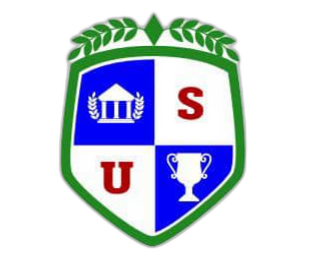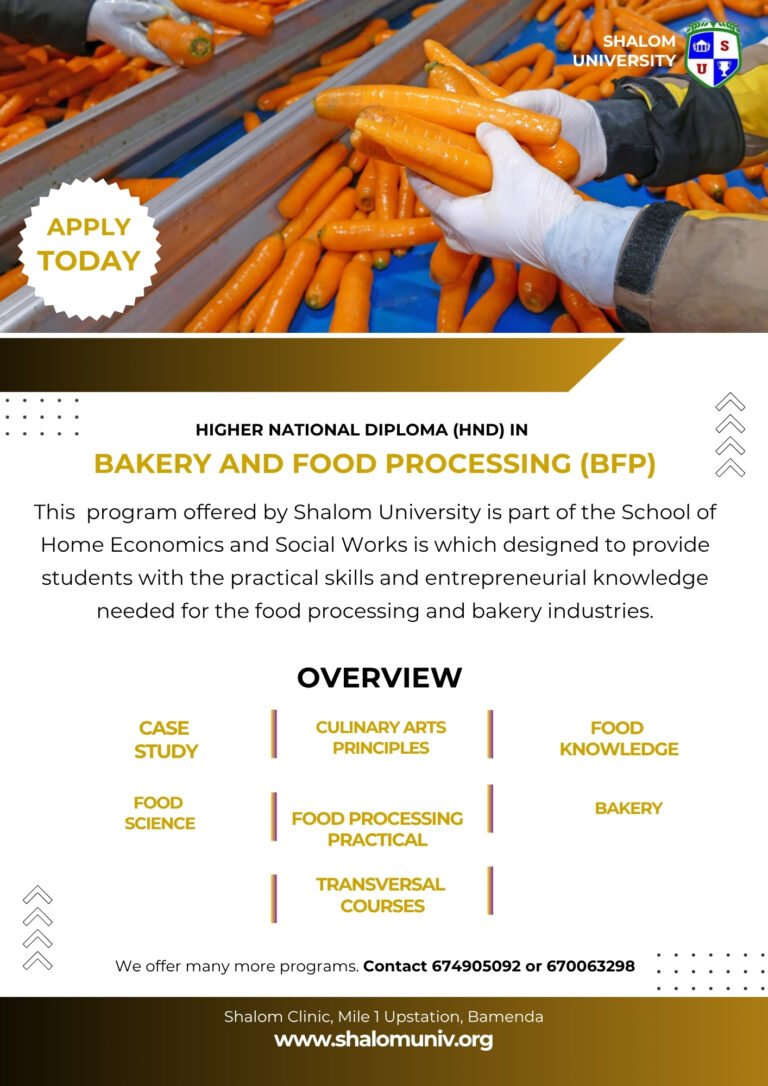In Cameroon, where cultural identity is vividly expressed through vibrant fabrics and unique clothing designs, the fashion, clothing, and textiles (FCT) industry holds immense potential for creativity and economic growth. From bespoke tailoring for special occasions to the creation of innovative, ready-to-wear collections, skilled professionals are the driving force behind this dynamic sector. The HND in Fashion, Clothing and Textiles at Shalom University in Bamenda is designed to train these professionals, offering a practical and creative program that equips students with the technical and design skills needed to excel in the Cameroonian fashion scene.
The curriculum at Shalom University is tailored to bridge the gap between traditional craftsmanship and modern industrial techniques, preparing graduates to navigate the complexities of local and international markets. The program fosters a deep appreciation for textiles and design while instilling the organizational and technical expertise required for a successful career in fashion.
The FCT Curriculum at Shalom University
The HND in Fashion, Clothing and Textiles program at Shalom University is structured around a set of core papers that provide a comprehensive and practical education in the field.
Paper: Case Study
The Case Study paper is a vital component that integrates all the theoretical knowledge and practical skills gained throughout the program. It challenges students to analyze complex scenarios within the fashion and textiles industry, from developing a new clothing line for a specific market segment to addressing production challenges in a local workshop. This is particularly relevant for fashion professionals in Cameroon, who must navigate market trends, consumer preferences, and logistical hurdles.
The course trains students to:
- Analyze real-world fashion business challenges: Based on a given case, students evaluate market opportunities, production bottlenecks, or branding strategies faced by a fashion business in Cameroon.
- Identify critical issues: They pinpoint specific problems related to design, fabrication, supply chain, or market positioning.
- Propose evidence-based solutions: Students formulate practical recommendations based on design principles, fabrication techniques, and market analysis. For example, a case study might involve analyzing a local designer’s business struggling with scalability and proposing a new work organization or production method.
- Defend their decisions: During formal presentations, students must justify their analysis and proposed solutions, demonstrating their critical thinking and communication skills, which are essential for effective management and stakeholder collaboration in the fashion industry.
Paper: Fabrication Analysis
This paper delves into the properties of various fabrics, from traditional textiles common in Cameroon, like “toghu” embroidery and local prints, to modern, industrial materials. Understanding fabric behavior is crucial for designers and pattern makers to ensure their creations are functional, durable, and aesthetically pleasing.
Key topics include:
- Textile Science: The physical and chemical properties of different fibers and fabrics, including natural fibers (cotton, silk) and synthetic fibers.
- Fabric Characteristics: How different weaves, knits, and finishes affect a fabric’s drape, durability, and suitability for various garments.
- Quality Control: Techniques for assessing fabric quality, including colorfastness, shrinkage, and strength, which are essential for maintaining consistent product quality.
- Local and Imported Fabrics: Understanding the characteristics and sourcing of both locally produced textiles and imported materials used in the Cameroonian market.
Paper: Advanced Sewing and Industrial Techniques
This paper provides students with the hands-on skills needed to execute complex garment construction using both advanced domestic and industrial sewing equipment. This training is essential for bridging the gap between small-scale tailoring and industrial-level production.
The curriculum covers:
- Advanced Garment Construction: Mastery of complex sewing techniques for creating high-quality, professionally finished garments.
- Industrial Sewing Machine Operation: Hands-on experience with industrial sewing machines, sergers, and specialized equipment used in garment factories.
- Production Line Techniques: Understanding the principles of assembly line production for efficient and scalable manufacturing.
- Quality Finishes: Techniques for achieving high-quality finishing details, including seam finishes, zipper applications, and hemming.
Paper: Work Organization and Research Methodology
In the fashion industry, creativity must be balanced with efficient and organized production. This paper equips students with the organizational and research skills needed to manage a production process effectively, from initial design concept to final product.
The curriculum addresses:
- Production Planning: The process of planning and scheduling production to meet deadlines and manage resources effectively.
- Workshop Management: Principles for organizing and managing a sewing workshop or small factory, including workflow, inventory, and equipment maintenance.
- Market Research: Techniques for conducting market research to identify trends, target audiences, and consumer needs in the Cameroonian fashion market.
- Fashion Forecasting: Methods for forecasting future fashion trends to inform design and production decisions.
Paper: Design Technology
This paper focuses on the creative and technological aspects of fashion design. It provides students with the tools and techniques needed to bring their design ideas to life, from initial sketches to digital renderings.
Key areas of focus include:
- CAD (Computer-Aided Design) for Fashion: Introduction to software used for fashion design, pattern making, and visualization.
- Fashion Illustration and Technical Drawing: Developing skills in creating detailed fashion illustrations and technical flats for production specifications.
- Pattern Making Techniques: Principles of creating and manipulating patterns to achieve desired garment fit and style.
- Trend Analysis: Understanding how to identify, analyze, and apply fashion trends in design.
Paper: Principles of Pattern Drafting
Pattern drafting is a fundamental skill for any fashion designer or garment technician. This paper provides students with a detailed understanding of the principles and techniques of creating patterns that ensure a perfect fit and professional construction.
The curriculum covers:
- Flat Pattern Making: Techniques for creating patterns from a block, including dart manipulation, slash-and-spread, and pivoting.
- Draping: The art of creating patterns by draping fabric directly on a dress form.
- Sizing and Grading: Principles of adjusting patterns to create different sizes for production.
- Cameroonian Body Proportions: Adapting pattern drafting techniques to fit the specific body proportions of the local population, ensuring a better fit for the Cameroonian market.
Cultivating Creativity and Entrepreneurship
Graduates of the HND in Fashion, Clothing and Textiles from Shalom University are well-prepared to enter Cameroon’s vibrant fashion industry. They can pursue careers as fashion designers, pattern makers, production managers, quality control officers, or launch their own fashion businesses. The program’s blend of creative design, technical skills, and business acumen, tailored to the Cameroonian context, ensures that graduates are not only skilled craftspeople but also savvy entrepreneurs. By providing a comprehensive and relevant education, Shalom University plays a significant role in nurturing the talent crucial for driving innovation, preserving cultural heritage, and growing the fashion and textiles sector in Cameroon.



